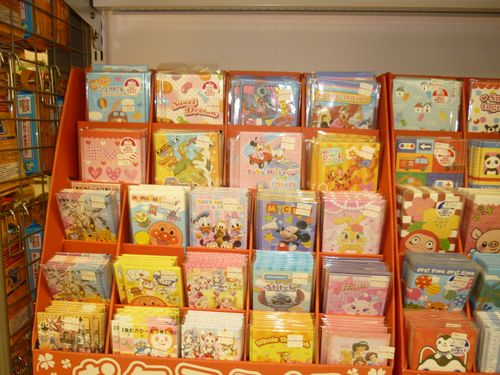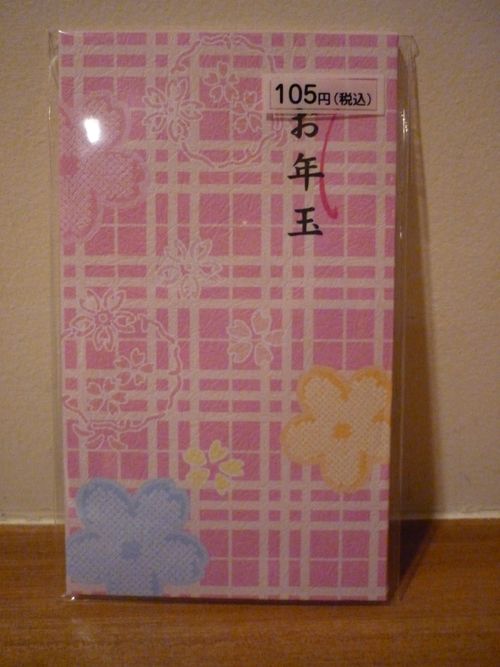CONTRIBUTED BY JANNINE MYERS
I wish you will have a good new year!
Yoi otoshi o omukae kudasai!
よいお年をお迎えください。

Otoshidama-bukuro (Otoshidama money envelopes)
The timing of this post is a little premature, by just a few weeks, but I’m headed home to New Zealand for the holidays and won’t be back till early January. I thought it would be fun before I leave however, to share with you some of the customs typically practiced in Japan and Okinawa, on or around New Year’s Eve.
One of the first things that crosses my mind when I think about previous New Year’s Eves spent in Japan, is otoshidama. At the end of every year, it is customary for children to receive otoshidama (monetary gifts). The money is presented inside specially designed envelopes called otoshidama-bukuro, and is given to children by parents, grandparents, and extended family members. In some cases, otoshidama is given to children who are not related at all. I remember feeling very humbled when several friends and neighbors on Yoron Island graciously gifted my daughter with otoshidama.
How otoshidama is utilized varies from family to family, but I believe it is common nowadays for children to spend the money as they wish. Some parents may insist on reserving some of the funds for future needs, such as college expenses, but more than likely, they will allow their child/ren to use at least some of the money for their own enjoyment. If you would like to get into the spirit of giving otoshidama to your own children, or to the children of some of your Japanese friends, you can purchase otoshidama-bukuro from any convenience or department store (see the photos above and below).

Another New Year’s Eve tradition I can recall is the serving of toshi-koshi soba (“year-end” soba noodles), right before midnight. I learned about this custom many years ago when we went home to New Zealand for Christmas, and took with us the daughter of our Japanese neighbors. Ayaka was just eleven years old at the time, but she was old enough to understand and appreciate the significance of observing an annual tradition, even though far away from home.
Just before midnight on New Year’s Eve, Ayaka began preparing the soba noodles her mother had sent with her, and one by one, she served each of us a bowl of hot, delicious noodles. Long noodles, also referred to as “year-crossing” or “year-bridging” noodles, are supposedly symbolic of a long “bridge” of health and prosperity; a bridge that starts in one year and continues on into the next. Eating such noodles will hopefully keep one on the path of good fortune.
One more custom I’d like to share with you is the custom of sending nengajo (New Year’s Day postcards) to friends and family. Just as we enjoy sending Christmas cards to loved ones, the Japanese love to send nengajo. The original purpose of nengajo was to touch base with and send well wishes to family members who lived faraway. Today, New Year’s Day postcards are not only sent to distant friends and relatives, but they are also given to those who live nearby and who are seen on a regular basis.
Several years ago, when I was here on a work visa, I used to receive stacks of New Year’s Day postcards from friends, neighbors, and co-workers. Many of the cards I received had been personalized with family photos and handwritten messages, while others had pre-printed greetings and designs on them. Some of the standard greetings you might see on a New Year’s Day postcard are:
Kinga Shinnen – Happy New Year
Akemashita omedetou gozaimasu – Wishing you happiness for the new year
Kotoshi mo yoroshiku onegaishimasu – I hope the new year brings you much happiness
If you would like to send some New Year’s Day postcards to some of your Japanese friends, you will need to post them via the Japanese Postal Service and mark them with the word nengajo; this will ensure that they are received on or just prior to New Year’s Day. You should be able to find nengajo in your local convenience stores, and also in most major bookstores. I saw a whole rack of them today at a bookstore inside Chatan Jusco, and I did try to get you a photo but I was quickly shooed away as soon as the cashier saw me reaching for my camera. They’re not that difficult to spot, and some of them actually have the English words “Happy New Year” written on them. And if all else fails, you can always make your own.
These are just a few of many New Years Eve traditions celebrated in Japan, and although they are all very different, they all represent the same thing: that is, the notion of bringing joy to others, and wishing each other much happiness in the year/s to come. With that said, I wish you all a very Merry Christmas and a Happy New Year!



GREAT POST!
My kids all knew how to say the “wishing you hapiness for the new year” last year they said it all the time and people were so surprised. This year I am going to say those phrases all over town.
Thanks, Jannine!!
Have a great trip and since I won’t see you.
Kotoshi mo yoroshiku onegaishimasu!